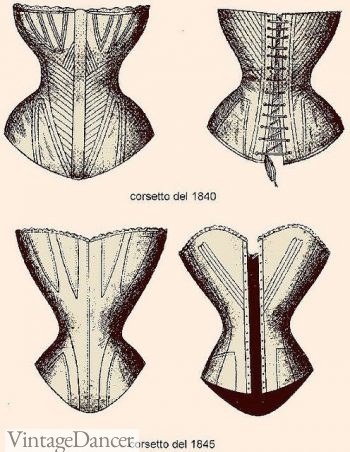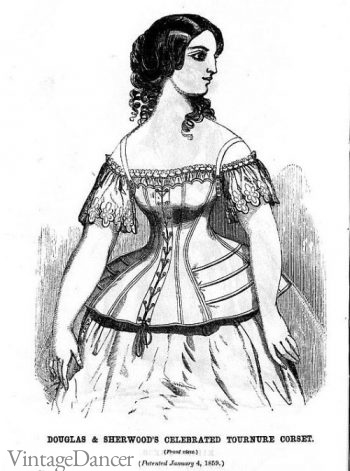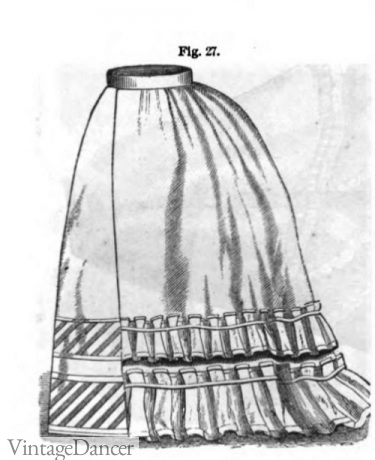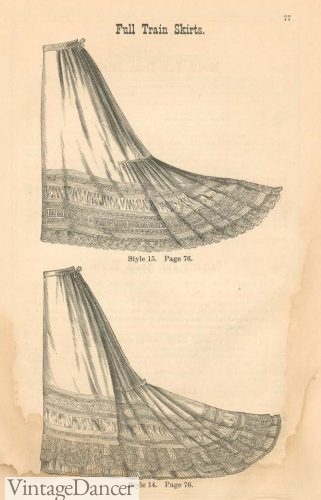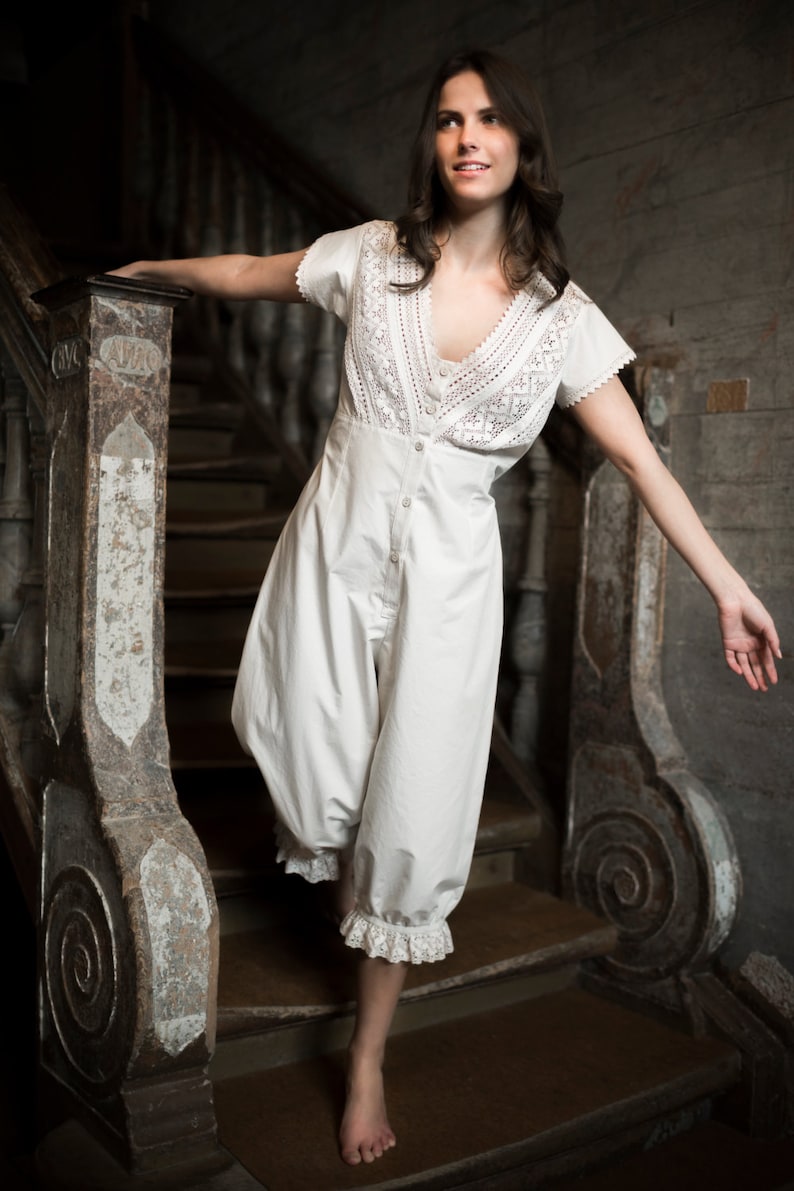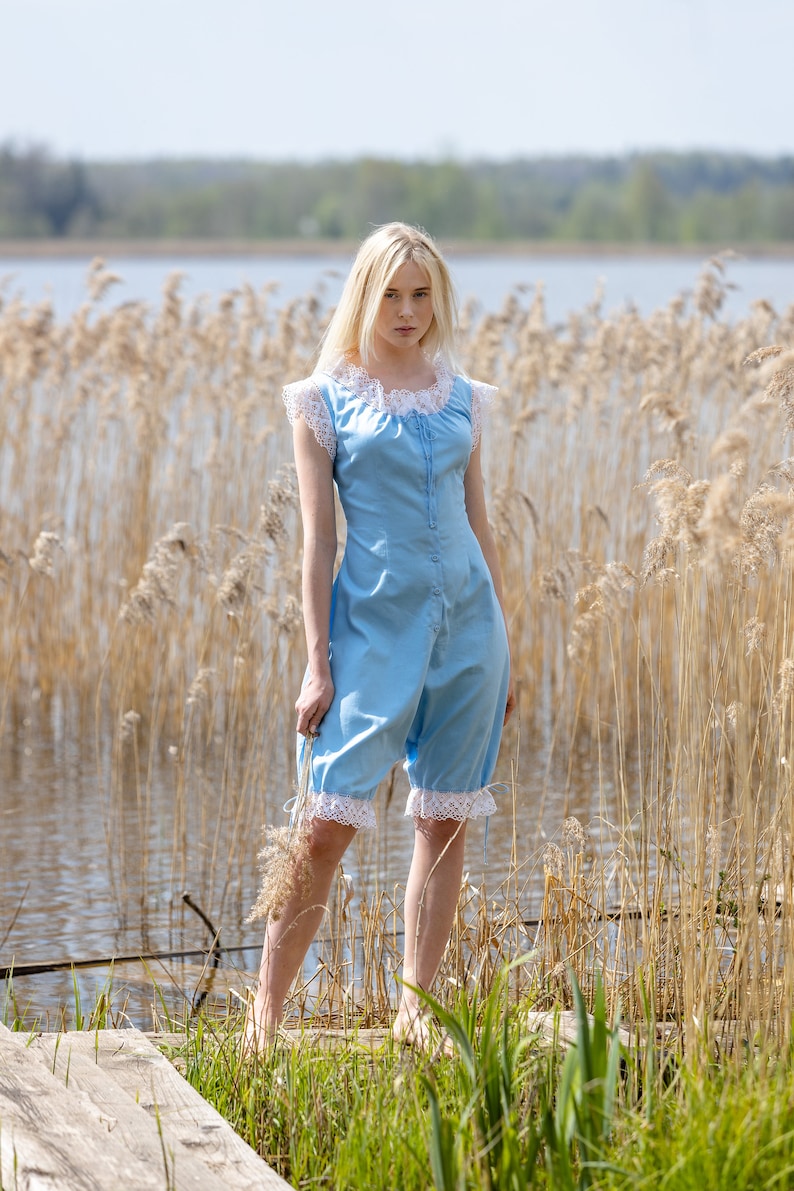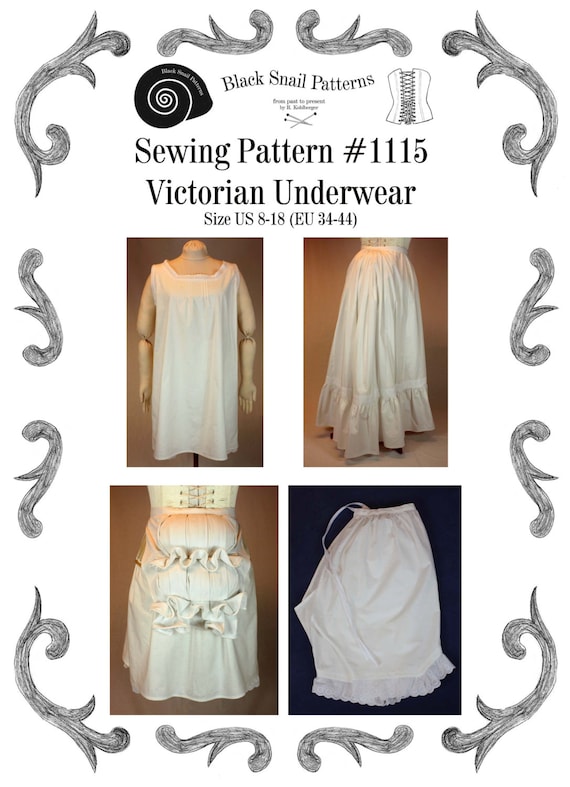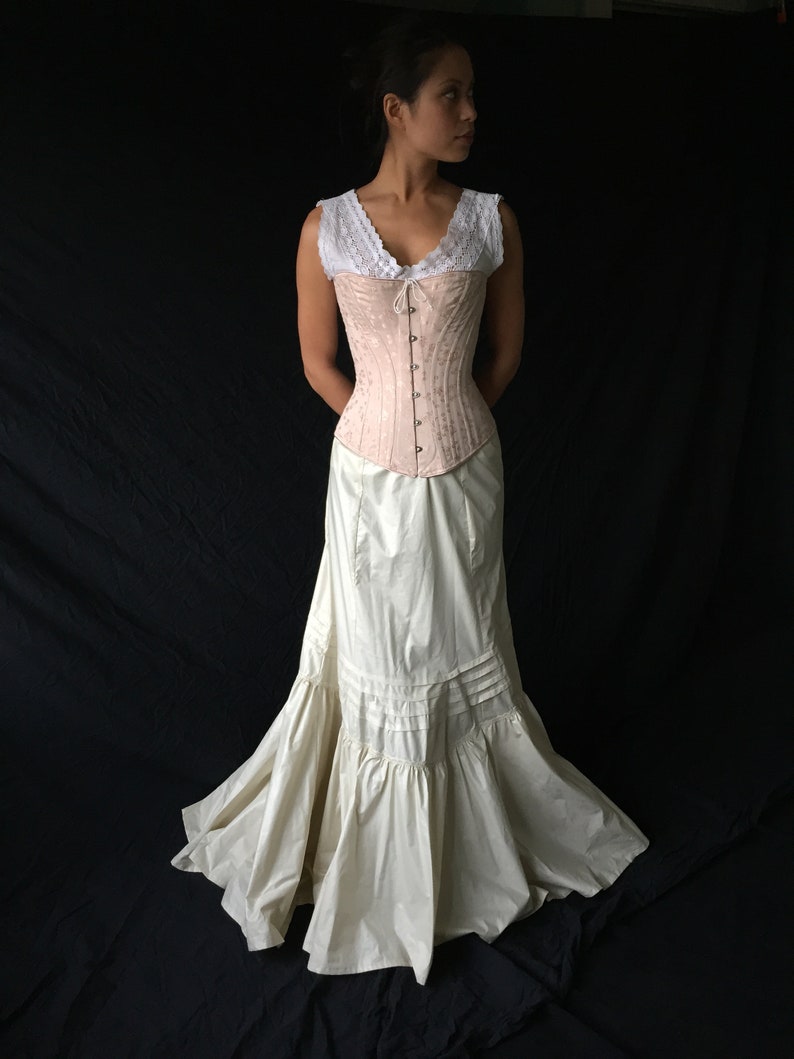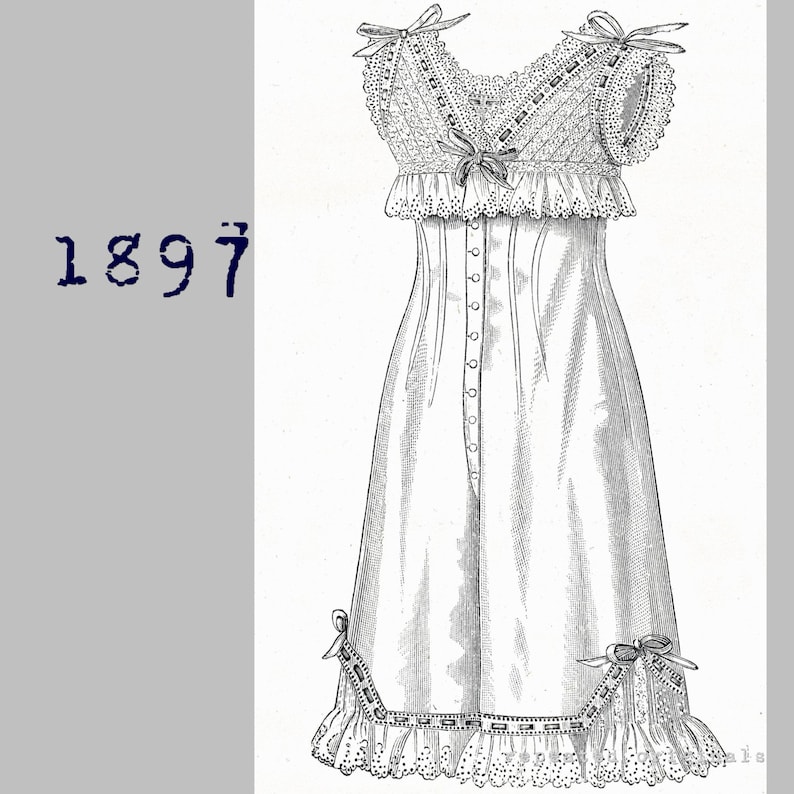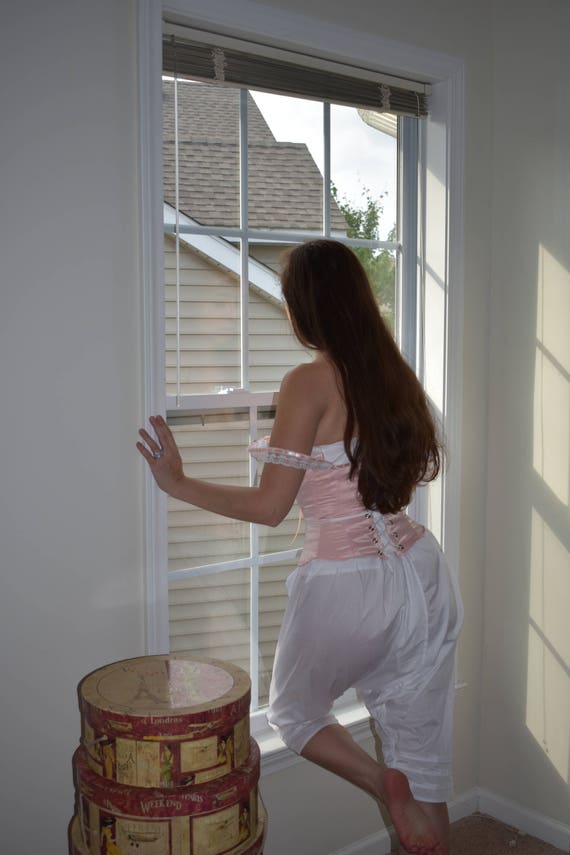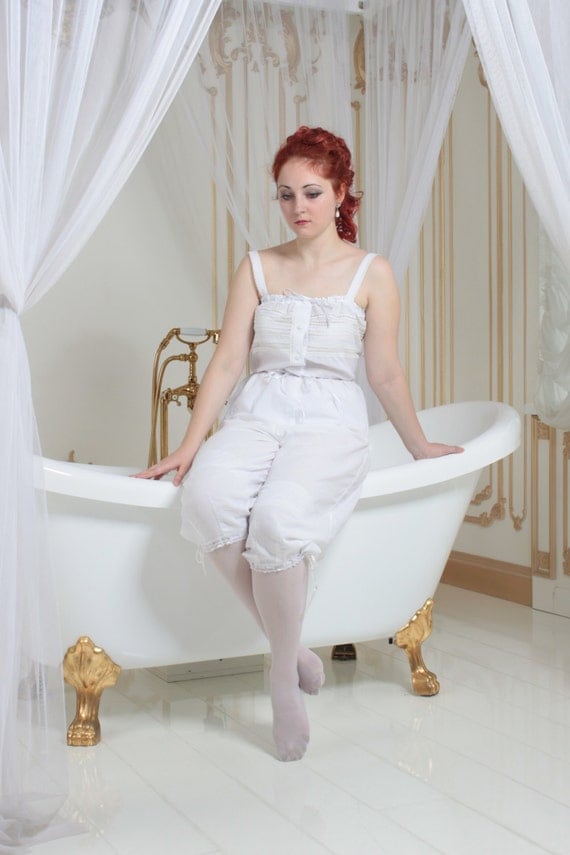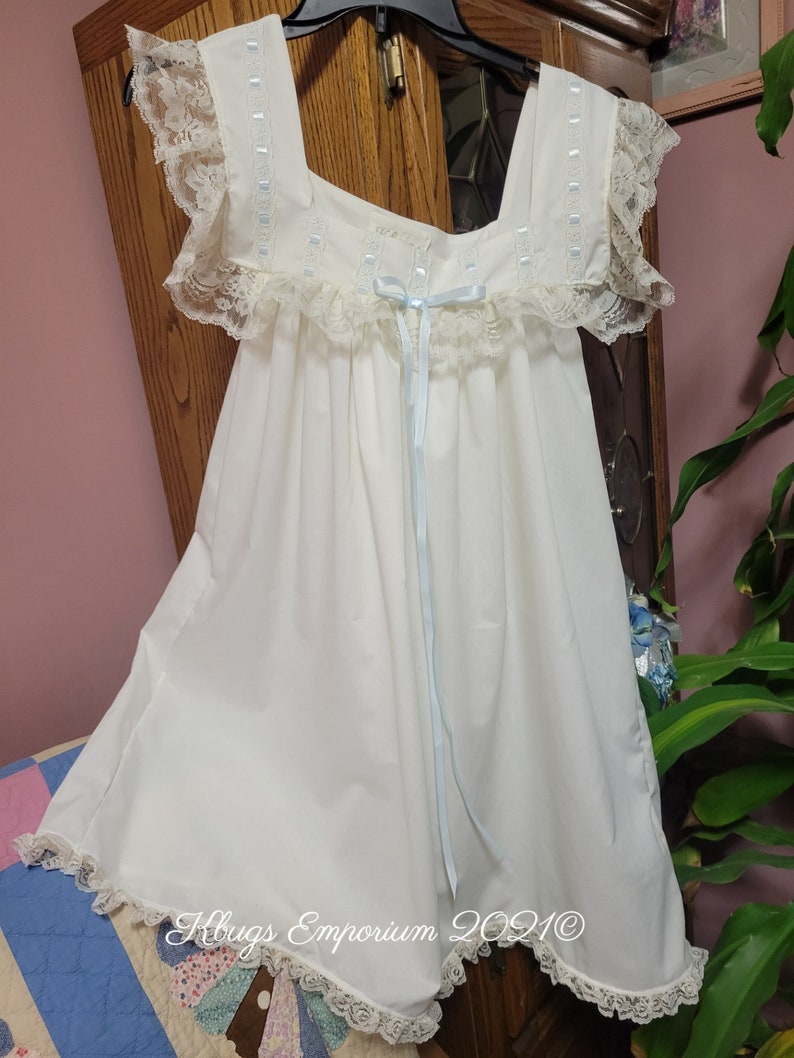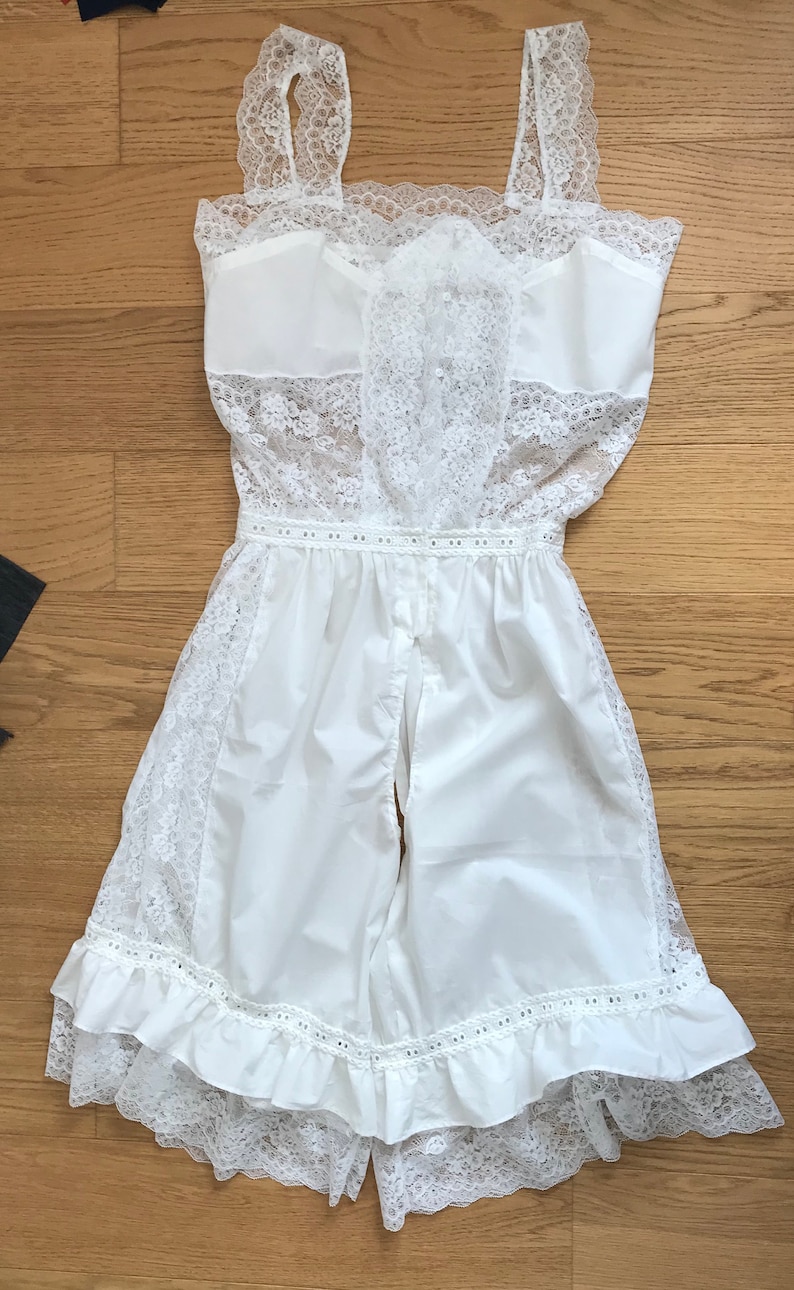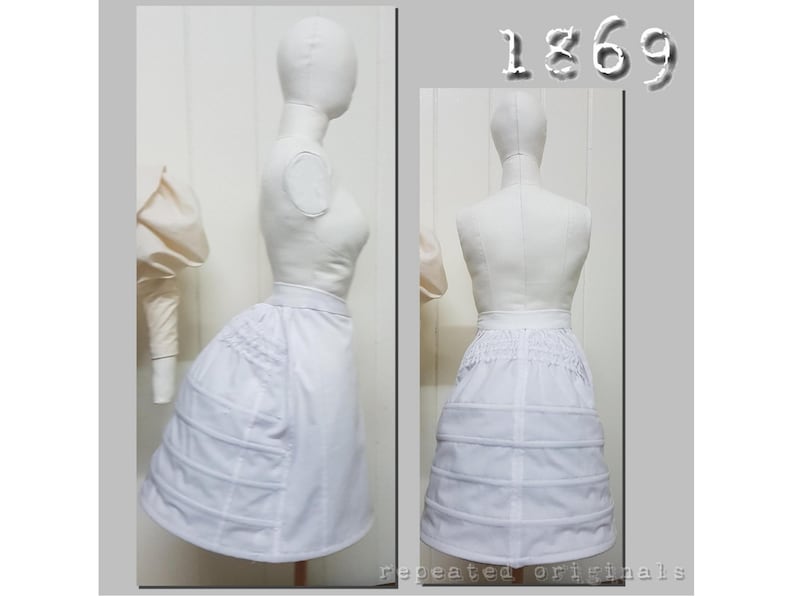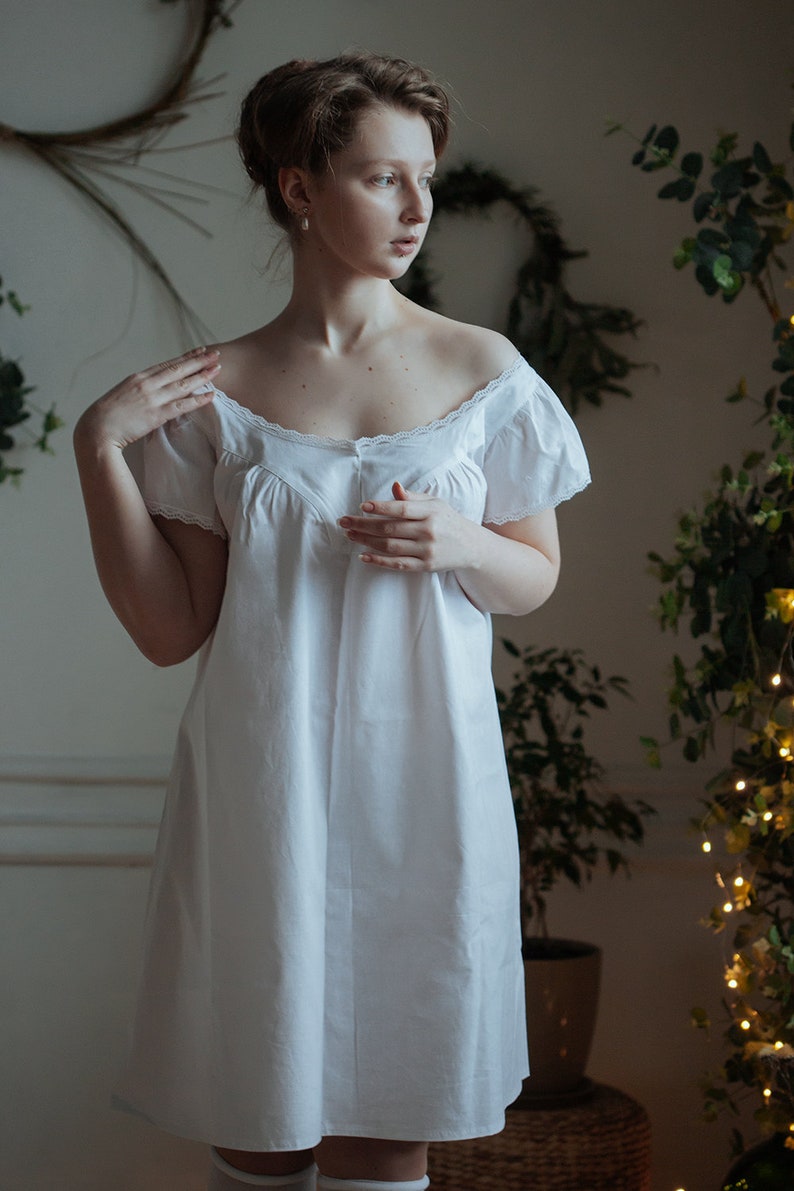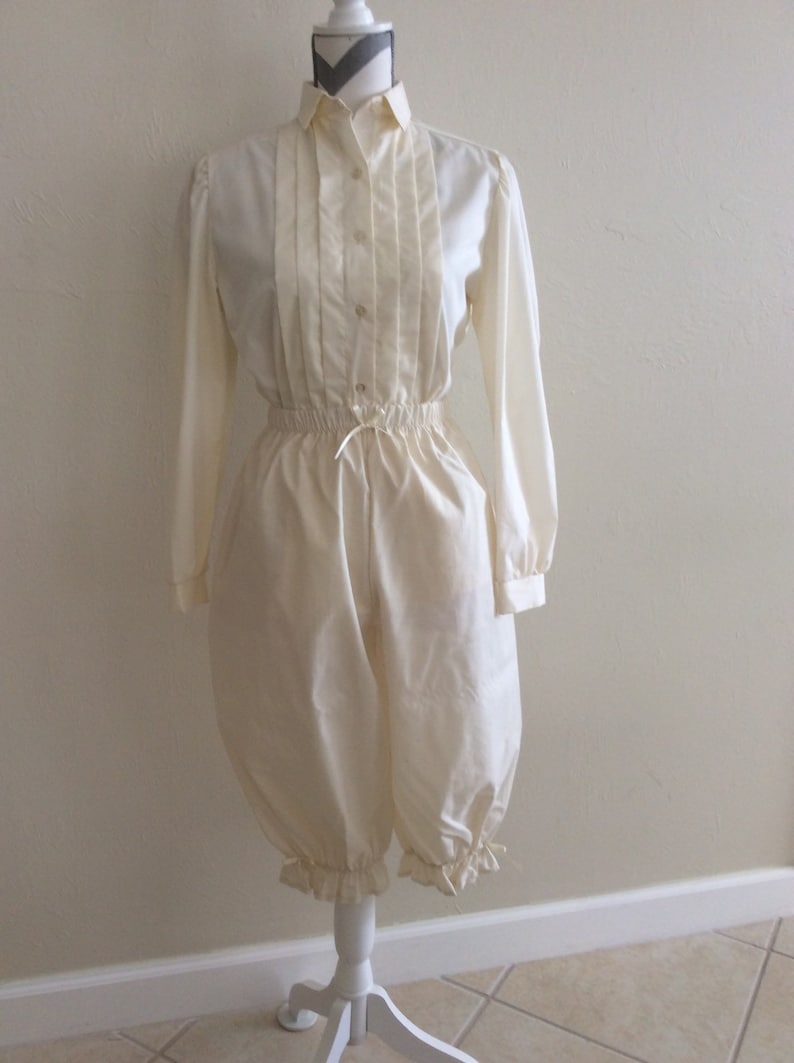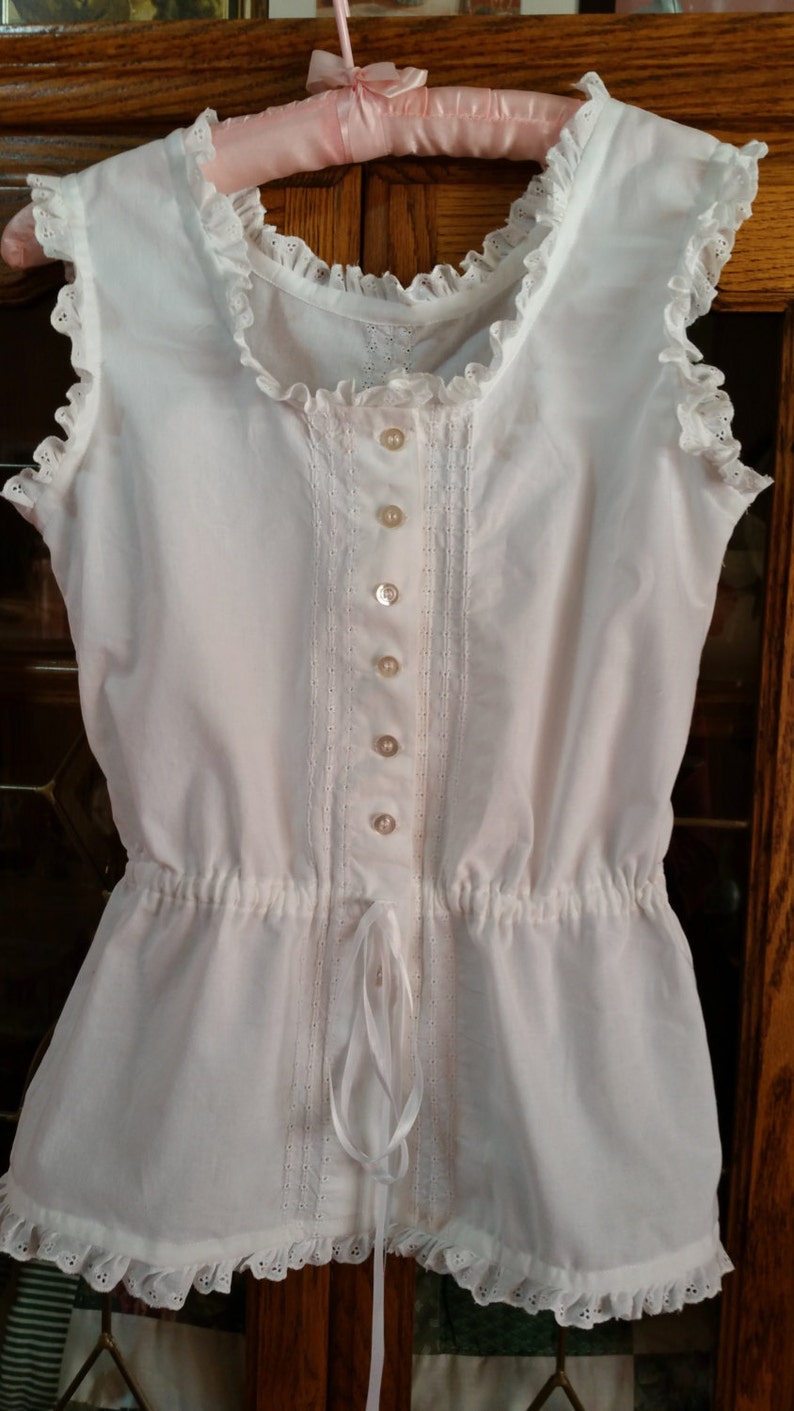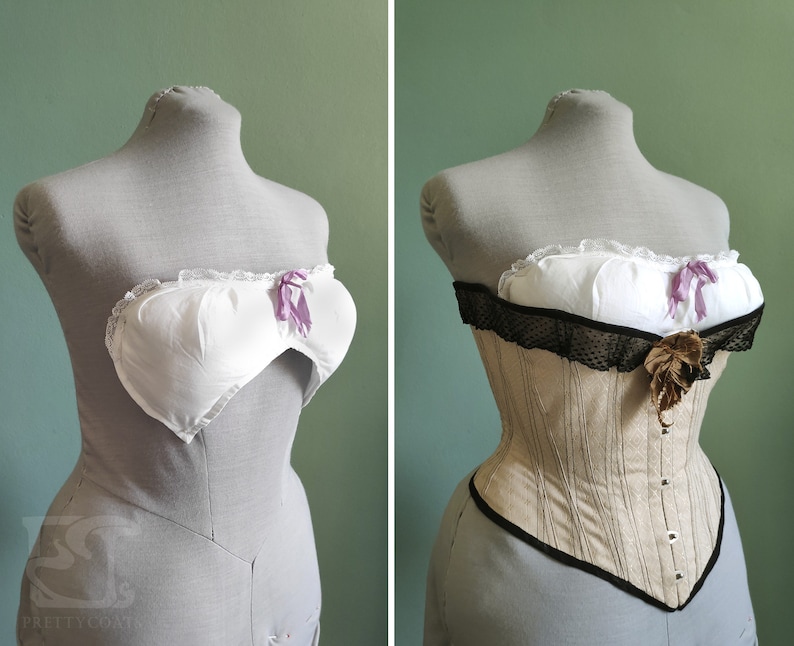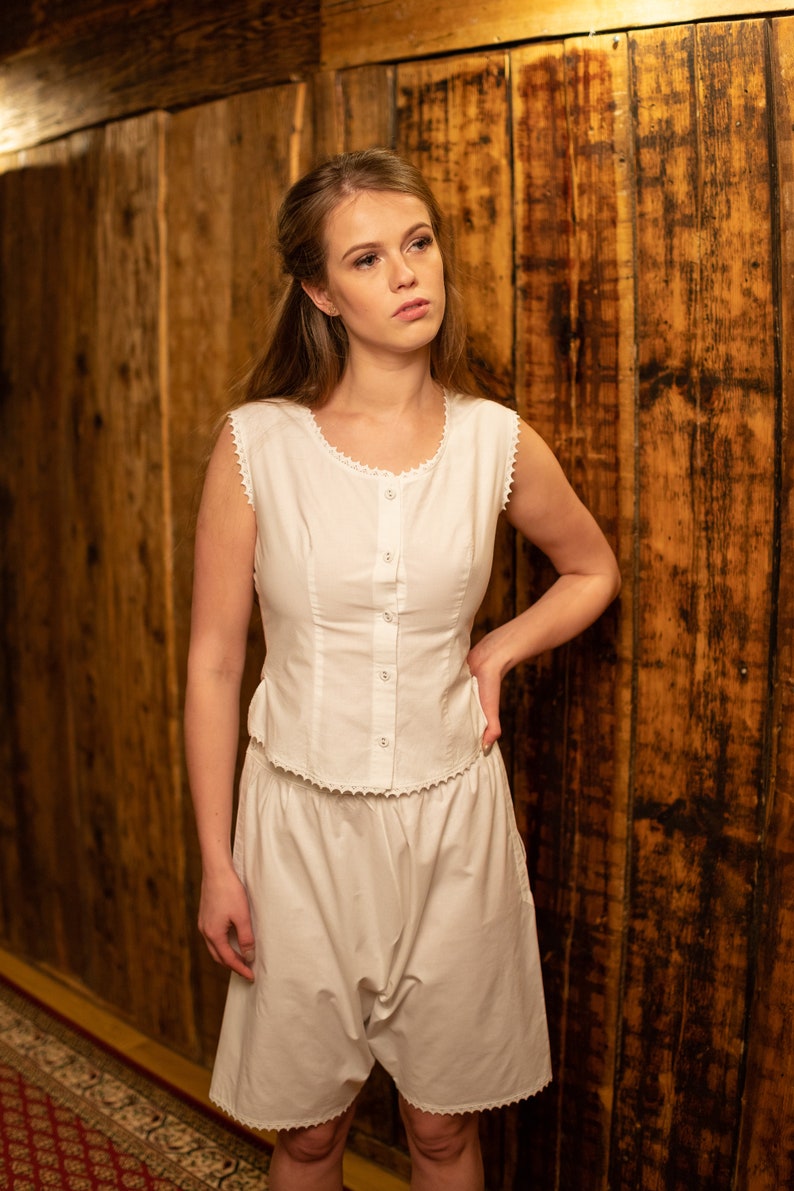The garments worn beneath the dresses of the Victorian period are important because of their share in producing the final effect of the dress. They also show an interesting development without reference to the contemporary dress. Throughout the period there was a gradual but uninterrupted movement towards greater decoration of Victorian lingerie and underwear, and a movement, slightly less certain, towards diminishing volume.
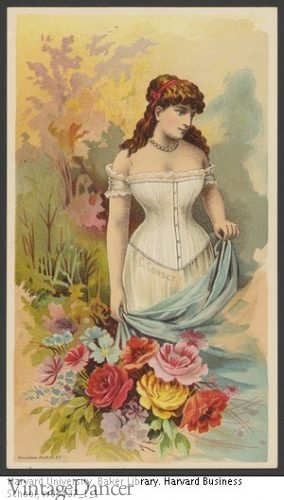
F.C. Corset corset ad
Victorian lingerie garments may be divided into two groups: underwear, the chemises and petticoats worn between skin and dress to protect each from the other, and at some periods to help to support the dress; and the structural underwear, the corsets, bustles and crinolines which mold or extend the human form into the shape of fashion.
The following article is largely quoted from Victorian Costume and Costume Accessories by Anne Buck, 1961.
Victorian Lingerie: Corsets
Corsets were worn throughout the period and these corsets give the shape of the upper half of the dress. During the 1840s /and 1850s, the corsets were long, back-lacing, with gussets over the hips and for the breasts, and with shoulder-straps. They were stiffly boned with whalebone and had a busk, long and about an inch and a half wide, in wood or whalebone, inserted at the center front.
During the 1860s, much shorter and more lightly boned corsets were worn, with the rising waistline of the dress. Front fastening was now general on a metal busk. Shoulder- straps disappeared after the 1840s. Quilted corsets were worn in this period, and scarlet, which appeared in petticoats and stockings, also penetrated to the corset.
Colored corsets were fashionable from this time onwards. Earlier examples from the 1840s and 1850s are usually in white, grey or fawn. The material was usually a strong twilled cotton or cotton satin.
- 1840s corsets
- 1859 corset
By 1875, long, tightly-laced corsets were once more necessary to give the sheath-like fashionable shape, the foundation of the cuirass bodice. The busk lengthened, then widened at the base and curved outwards, giving the “spoon” busk characteristic of corsets of the 1880s and early 1890s.
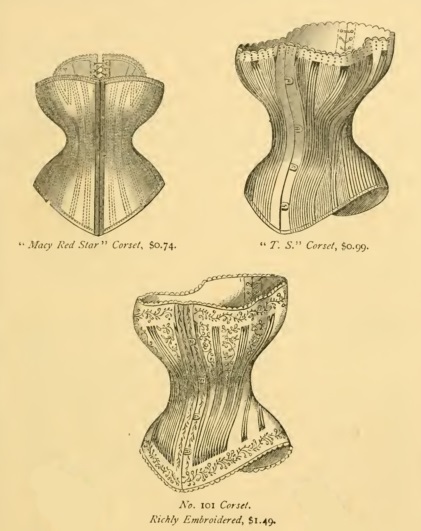
1877 Victorian corsets (Red or white)
Corsets with back lacing only were sometimes worn because the front fastening might show beneath the sheath-like bodice.
Corsets of 1875 to 1890 were particularly strong in construction, with elaborate cutting in sections and boning, some being reinforced with bands of leather. They also became increasingly elegant, made in satin or figured silk, and many of this period and in the 1890s were black, stitched in colors.
Trimming of lace and ribbon at the top of the corset became more elaborate in the 1880s and 1890s.
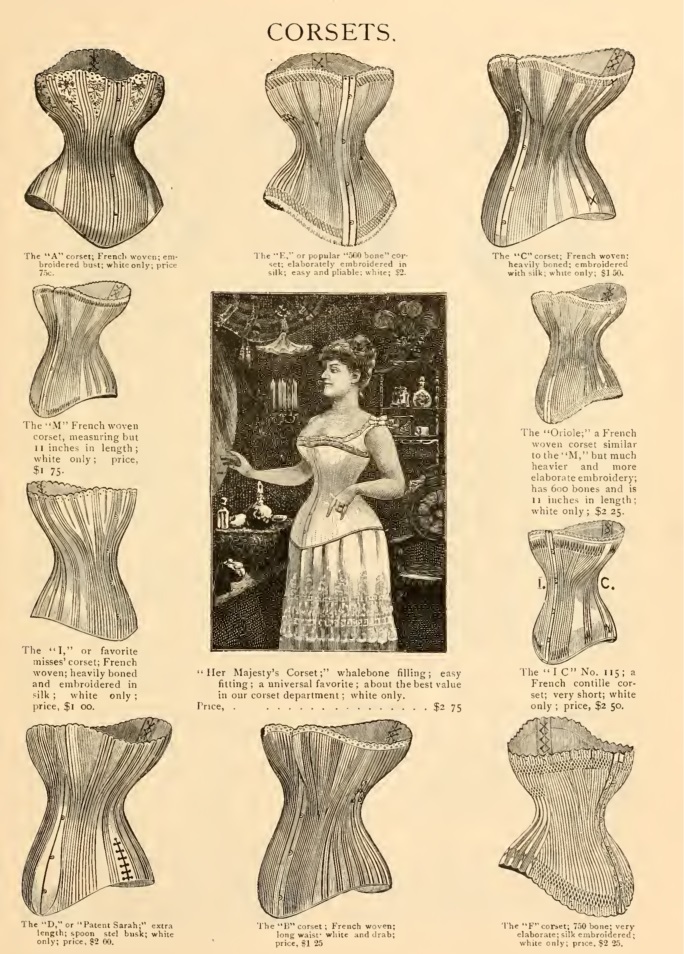
1886 Corsets
In the 1890s the front busk lost the spoon-shape, becoming narrower and straighter; but corsets were still long with complicated boning. There was also an alternative corset, shorter and lighter, like a deep Swiss belt, sharply pointed at top and bottom, which was worn for sport or as a negligee corset.
Bust improvers may be found sewn inside some dresses at almost all periods, but particularly in the 1840s. Bust bodices, for wearing beneath jerseys and blouses (i.e. unboned bodices), were introduced in 1889.
Suspenders, “English garters”, were worn from the 1880s, but were not attached to the corset until the end of the century.
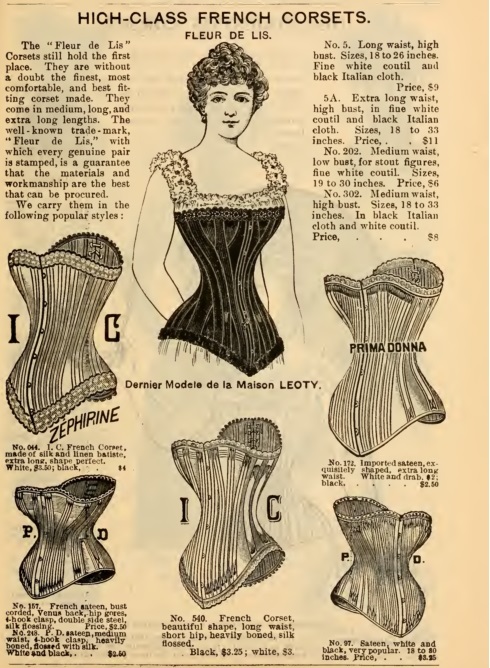
1897 French corsets
Victorian Bustles & Crinolines
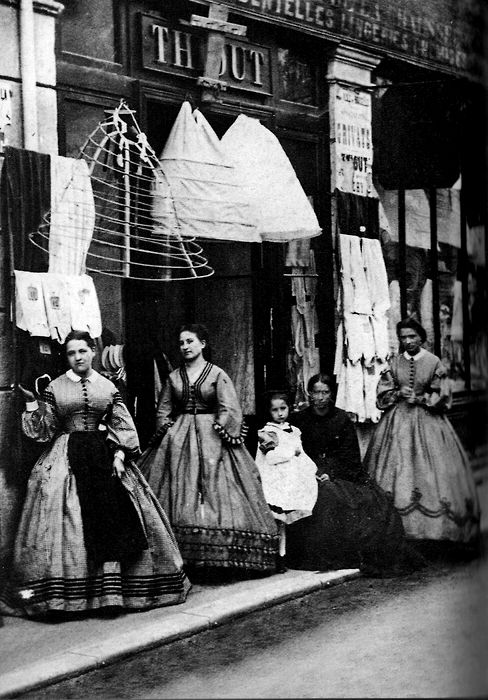
1860s hoops and petticoats for sale
Bustles were worn at the opening of the reign to support the fullness of the skirt. These were crescent-shaped pads filled with down or stiff frills of strong cotton satin or twill, tied around the waist. As the skirts grew wider, support was given by increasing numbers of petticoats, stiffened by their corded weave; and, in particular during the 1840s, by a stiffened petticoat of horsehair, the crinoline petticoat.
In the 1850s, hoops of whalebone were inserted into a petticoat to support the wider skirts and from this a framework, first of whalebone and later of thin flexible steels, was evolved which was now called the Victorian crinoline. This framework was flattened in front in the late 1860s and became a half crinoline.
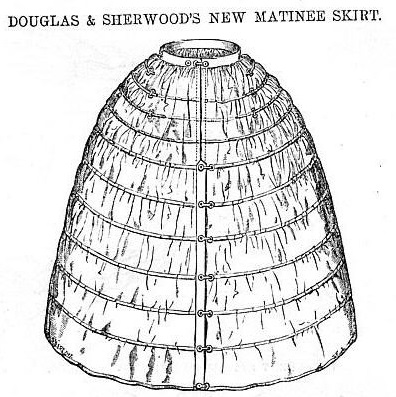
1859 Matinee Crinoline with Hooks for easy removal. Made of muslin with boned hoops
In the 1870s, this half-crinoline swelled at the top into a bustle or a separate bustle was worn with it, and then, as the fullness left the hem of the skirt, the bustle without the half-crinoline was worn alone. The bustles of this period— the early 1870s—were usually of puffed and frilled horsehair, extending in a wide curve across the hips.
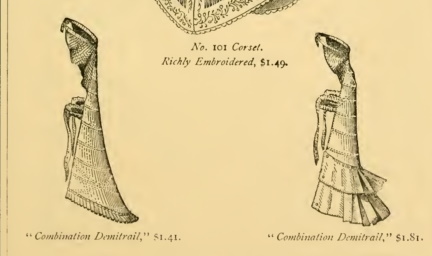
1877 bustle forms
During the late 1870s, no bustle was worn, but flounces were added at the base of the petticoat to throw out the hem. A bustle had returned again by 1883. The form of this was different from the bustle of ten years earlier.
The bustle of the mid-1880s, “the camel’s hump”, was usually of steels, often mounted in a half-petticoat, which formed half-circles of short diameter, but stiff frills of horsehair were also worn.
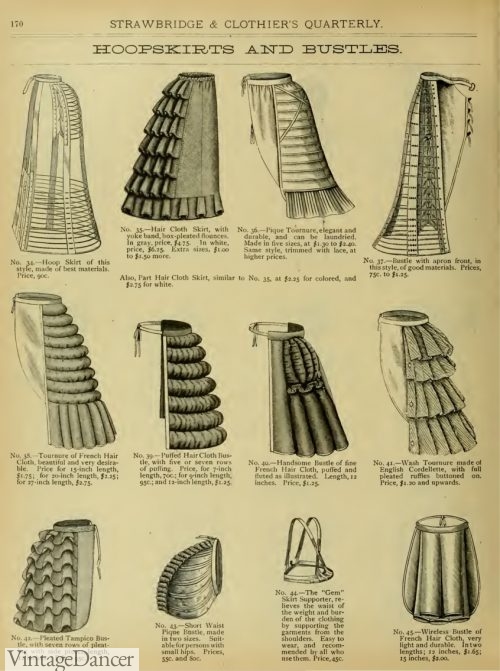
1882 bustle skirts, bustle pads and crinolines
Bustles disappeared about 1890, although a small pad was often inserted beneath the fullness of dresses at the center back in the early 1890s.
Victorian Petticoats
Petticoats usually show the same shaping as the dresses they supported. At the beginning of the period, some petticoats were still full-length, with a sleeveless bodice. They fastened at the back and were shaped with a pointed waistline like the dresses, with the skirt set on to the bodice in gathers or close pleating. Waist-length petticoats were, however, the more usual form for most of the period.
In the late 1870s, a princess petticoat form, sheath-like in front like the dresses, was once more an alternative style, and remained in fashion until the end of the century, although the waist-length petticoat was still the general style.
- 1872 petticoat
- 1879 petticoats
In the 1840s the petticoats were very full, gathered on to a shaped waistband which fastened with buttons or a drawstring at the back. An under-petticoat of horsehair was used as a support for the widening skirts; but instead of this, or as well as this, supporting petticoats of cotton, woven with a thick cording of the fabric so that they stood out stiffly to support the skirt were worn. In the middle of the century, cotton petticoats often had a hem of openwork embroidery.
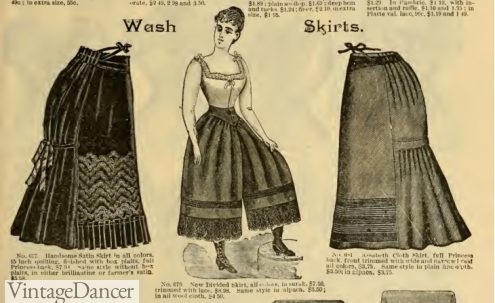
1890 petticoat and split drawers petticoat
During the 1870s and 1880s, they usually had the tied back and flounced hems, which repeated the lines of the skirt and shared the increasing ornament of all underwear. Separate petticoat trains which buttoned on were worn in the late 1870s. Very elaborate petticoats were worn in the 1890s: “the petticoat requires as much fitting as the overskirt and, of course, like the latter, is severely tight round the top” (Lady’s Realm, 1898-g).
At the end of the 1890s particularly, they were much trimmed with flounces at the hem.
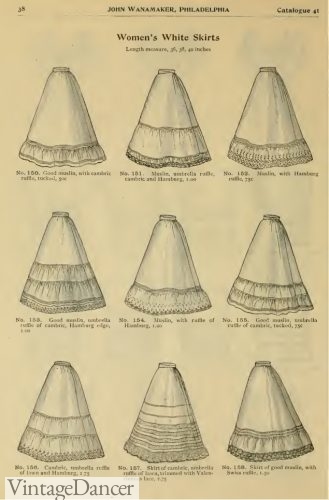
1896 white skirt petticoats
Flannel petticoats were worn for warmth from the beginning 1 of the reign and, from the 1860s, when scarlet flannel was popular, the flannel might be colored. Colored satin and alpaca were also used for petticoats, chiefly in the last quarter of the century. Quilted down petticoats were worn in winter in the 1880s.
Knitted wool petticoats of a knee length appeared in the 1890s. These were worn with a white full length petticoat over them. Victorian winter underwear was quite warm, with multiple layers to keep out the cold. Combined with wool stockings and union suits (long johns) a woman was layered in several pieces of underwear.
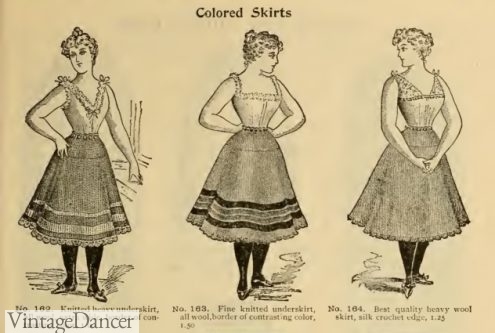
1896 knit petticoats. A white petticoat was worn over these.
The quantity of petticoats worn varied greatly, from the five or six used to support the skirt in the 1840s and early 1850s, when there was no crinoline frame to do most of this work, to the single petticoat which was all that could be worn beneath the dresses of the late 1870s. Sometimes even this was omitted, and flounces were attached inside the lower part of the skirt instead.
With the crinoline frame, one or two petticoats were all that were needed. The number and kind of petticoats worn varied also according to dress and according to season.
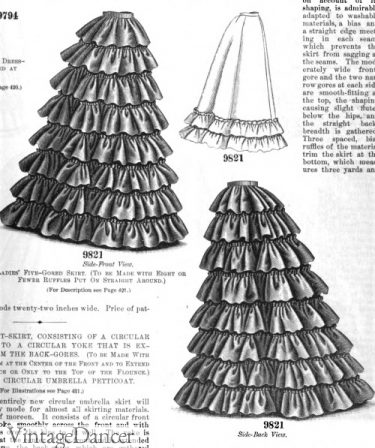
1898 ruffle tiered petticoats
Victorian Chemise
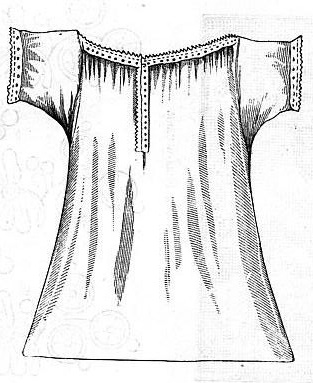
1859 simple cotton chemise
Chemises were worn throughout the period. Those of the 1840s and 1850s were usually plain and voluminous and made with a square, falling flap in front, which folded down over the top of the corset. The short sleeves had a square gusset under the arm and were gathered into a band; usually, there were gores at the sides.
After 1860, the falling flap disappeared and around, low neckline with short front opening was usual. During the 1870s and 1880s Victorian era the chemise generally became shorter, more shaped to the figure and sleeveless.
Short waist-length undergarments to cover the corset were worn mainly in the second half of the century, replacing the falling flap of the chemise. They were shaped for the waist and usually had a front opening. In the 1870s and 1880s they were called petticoat bodices, but later were known as camisoles.
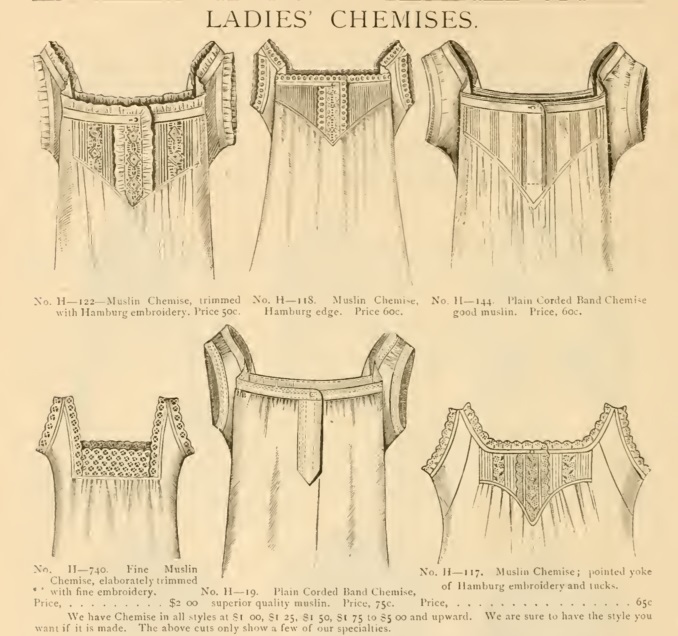
1886 chemises
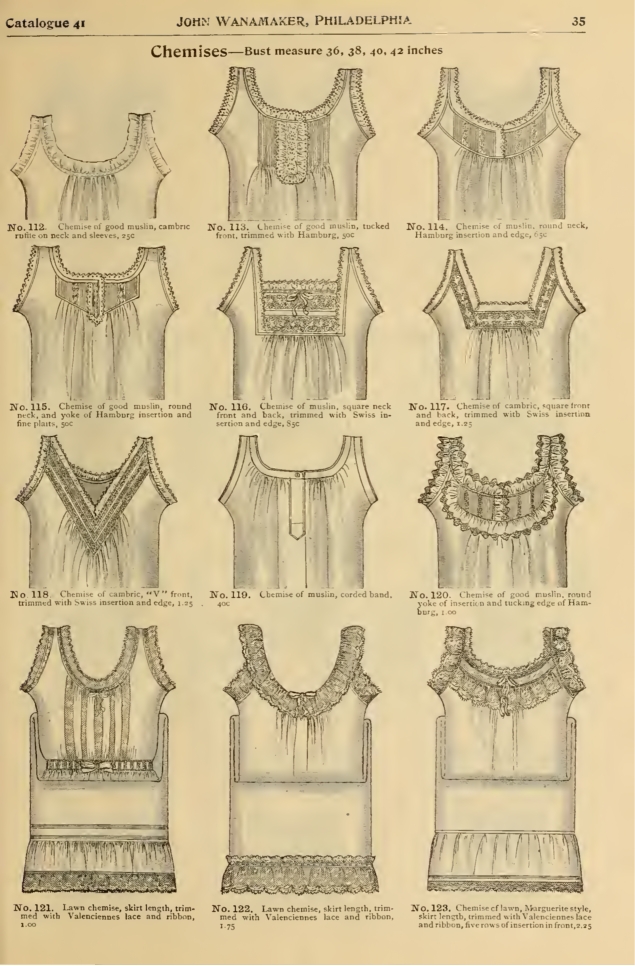
1896 Chemises
Victorian Drawers / Bloomers
Drawers, or bloomers, were only just becoming generally worn in the 1840s. They were made with two tubular legs, the inside seams open in the upper half and the two legs linked only by the band at the waist. The legs ended well below the knees in the middle years of the century but shortened to the knees during the 1870s.
The open-legged shape continued in use until the end of the century, but during the 1880s a form with the legs seamed together, and opening at the sides to fasten together at the waist, came into use.
The legs now, instead of being straight, were gathered into a band with a frill below. During the 1890s the legs were often very wide and full.
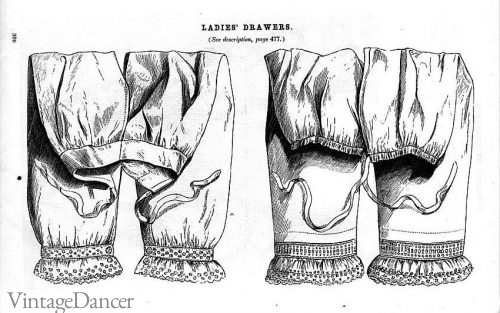
1859 drawers bloomers
Combinations were an undergarment contemporary with the sheath-like dresses of the late 1870s. They were chemise and drawers in one garment designed to reduce the volume of Victorian underwear beneath these dresses. This was an undergarment for which knitted woolen fabric was often used.
Elaborate combinations in silk and muslin with full wide legs trimmed with lace were worn in the 1890s, although in 1897 it was stated that “the fashion for wearing combinations is followed by very few people and indeed, one may say, by none of the smart set, who never really took to this form of underwear” (Lady’s Realm, 1897).
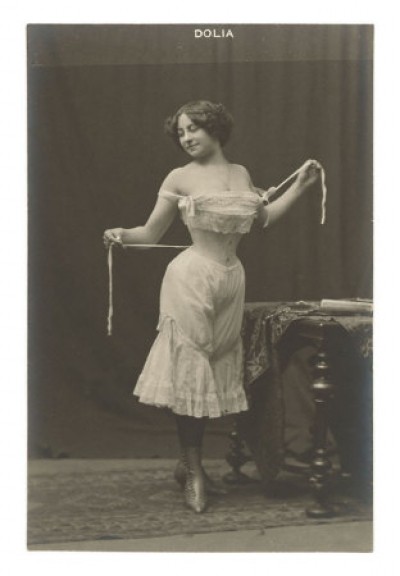
1890s wide leg bloomers
Linen was still the usual material of underwear at the beginning of the period, although cotton was also used. Both materials appear in varying degrees of fineness. At this time very little ornament appeared, usually only frilling of muslin at neck and sleeves.
During the middle years of the century, more cotton was used and more decoration appeared—narrow insertions and frills of openwork embroidery and, at the hems of petticoats, often a deep flounce of the large-holed openwork, broderie anglaise.
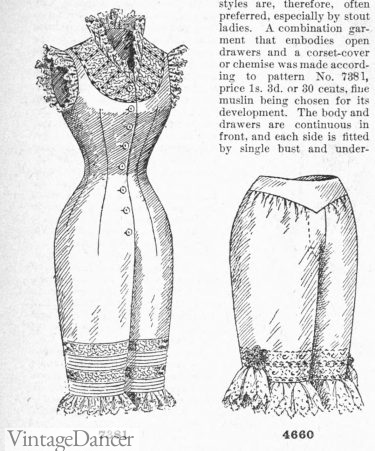
1895 drawers and combination suit
Trimming increased during the late 1870s and 1880s, much of the embroidery now being machine-worked. Tucks were used ornamentally with insertions of embroidery and lace. Silk began to be used for underwear in the 1880s:
“Underclothing is now made of soft silk and is as much trimmed with lace as our dresses, with hand embroidery most beautifully done” (Sylvia’s Home Journal, 1880).
At the same time wool also began to be used for underwear: “we wear wool not only in undergarments, where combinations fully trimmed with lace are banishing linen and cotton almost entirely but in dresses, bonnets and cloaks” (Woman’s World, 1888).
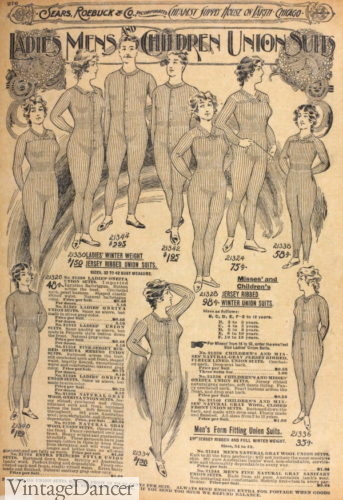
1897 wool union suits for women, men, child
Union suits (one peice) and earlier two peice (tops and long drawers) made of wool or cotton knit were essential in winter moving into the Edwardian era. Lighter knits were made for summer seasons too.
“German physician Gustav Jaeger advocated wearing wool undergarments next to the skin for health purposes in his book Sanitary Woolen System, first published in 1878. Flannel and jersey underwear made of undyed sheep’s wool was believed to conserve vital energy, prevent microorganisms from penetrating the skin, and wick perspiration away from the body. Jaeger considered linen and cotton undesirable because they retained dampness, causing illness. The doctor discouraged dyes, because he believed they contained harmful chemicals that were absorbed by the bloodstream. ” – FIDM Museum
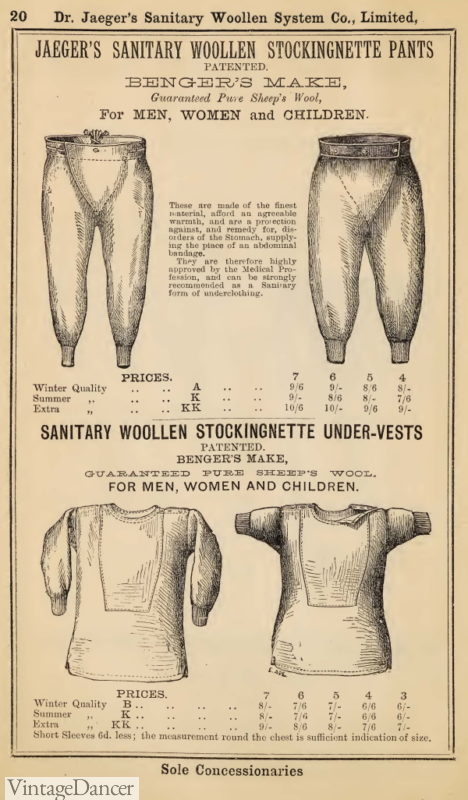
1883 Dr. Jaegers Wool Underwear
Victorian Lingerie Order
The first layer of clothing were bloomers, pantaloons, or drawers that acted as underwear. Split drawers made them functional when using the facilities. Then came a chemise for the top half. They looked like a loose cotton tank top or summer nightgown.
Next was the corset or the bust supporter before the brassiere was invented, and an optional corset cover. It protected both the corset and the dress from friction.
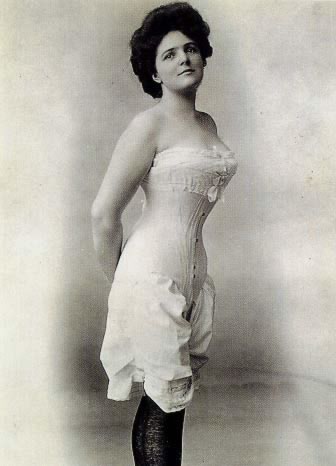
Late Victorian underwear layered correctly (a chemise goes over this outfit)
The final set involved a petticoat slip and petticoat skirt (or crinoline) over either a hoop skirt or bustle pad. Sometimes another petticoat slip was worn over that! Then at last, it was time to wear the dress. The Edwardian era (1900s, 1910s) followed the same dressing pattern.
Shop Victorian Lingerie Underwear
Looking for robes, pajamas and Victorian nightgowns? We have links to those too.
Debbie Sessions has been teaching fashion history and helping people dress for vintage themed events since 2009. She has turned a hobby into VintageDancer.com with hundreds of well researched articles and hand picked links to vintage inspired clothing online. She aims to make dressing accurately (or not) an affordable option for all. Oh, and she dances too.
